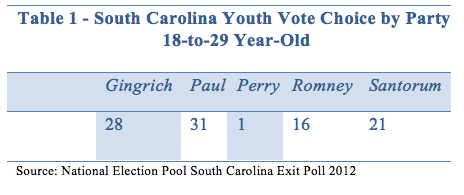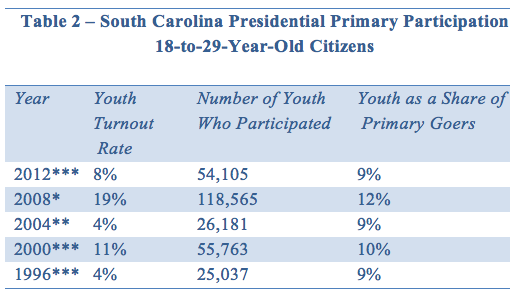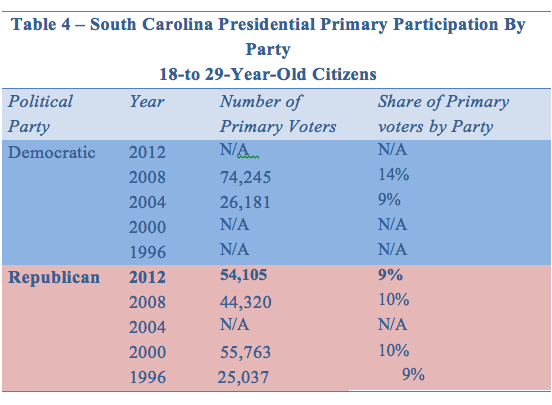South Carolina Youth Turnout 8%
As in Iowa and New Hampshire, Paul Wins Youth Vote; Gingrich Just Three Points Behind and Santorum in Third
MEDFORD/SOMERVILLE, Mass. – Eight percent of eligible voters under the age of 30 in South Carolina participated in last night’s primary, according to preliminary analysis by the Center for Information & Research on Civic Learning & Engagement (CIRCLE). Thirty-one percent of these young voters supported Congressman Ron Paul, followed by former Speaker of the House Newt Gingrich at 28%, Rick Santorum at 21%, and Mitt Romney at 16%. (See Table 1.)
Paul increased his support among young South Carolina voters more than fivefold since 2008, drawing an extra 13,671 youth votes. (See Table 3). However, compared to Paul’s support in 2012, Barack Obama drew almost three times as many young voters in the 2008 South Carolina Democratic primary and went on to win a majority of the youth vote in that state in the general election.
Total youth turnout doubled compared to the most recent year in which only one party held a competitive primary, 2004, but it fell compared to 2008, when South Carolinians had the opportunity to vote in either a Republican or Democratic competitive primary. Overall youth turnout was higher in 2008 (at 19%) and in 2000 with (11%), but in those years both the Republicans and the Democrats held competitive races in South Carolina. (See Table 2.) In the 2008 primary, an estimated 44,320 young people voted in the Republican primaries. In 2012, about 54,105 young people voted – an 18% increase.
Because of a lack of available data, the CIRCLE turnout estimates do not include young people who participated in yesterday’s uncontested Democratic primary.
* Combines the Democratic and Republican figures. For separate results by party, see Table 3
**2004 statistics only include the Democratic Primary. There was no Republican primary in 2004, because President George W. Bush was an incumbent and the GOP nomination.
***2012, 2000, and 1996 statistics only include the Republican primary, either because there was/is no Democratic Primary, because there was an incumbent president from the Democratic Party that took the nomination, or no information is available on youth turnout in the Democratic primary.
Source: The share of primary participants is obtained from the 2012, 2008, and 2004 SC exit poll conducted by Edison Research, and the 2000 and 1996 SC exit poll conducted by Voter News Services. The numbers of votes cast are obtained from the Associated Press as of 7:15 am, Eastern time, 1/22/2012, at 100% reporting. The numbers of votes cast in the past election years were obtained from various sources including the Washington Post archives (1996), Federal Election Commission (2000 and 2004), and CNN.com (2008). Estimated voter turnout is obtained by taking the estimated number of votes cast by young people and dividing it by the estimated population of the 18-to-29-year-old citizens from the Current Population Survey (1995-2011). See p. 2 for definitions.
Paul’s estimated 16,773 young votes makes him the most successful Republican candidate in the South Carolina primary in either 2008 or 2012 in terms of the youth vote, but Barack Obama drew almost 50,000 young votes in the South Carolina Democratic primary in 2008.
Comparisons to past years must be made with caution, because turnout is affected by the date of the caucuses and by the nature of the Democratic and Republican presidential campaigns, which are different in every cycle. For example, in 2008 both the Republicans and Democrats held primaries, but in 2012 only the Republicans held a competitive primary. Table 4 provides estimates of youth participation in South Carolina primary by party and year.
Definitions
- Youth: For the purpose of this press release and estimation of youth participation in the South Carolina Primary, we define “youth” as citizens who were eligible to vote on January 21, 2012, as permitted by state election law.
- Number of youth who participated: An estimate of how many youth participated in caucuses or primaries.
- Youth share: An estimate of the number of young people who participated in the primary as a percentage of the number of all people who participated.
- Youth turnout rate: An estimate of the number of young people who participated in caucuses or cast ballots as a percentage of the total number of young people who were eligible to participate on January 21, 2012.
- The youth turnout rate is the best indicator of how young Americans are engaging in the political process. The other statistics—the sheer number of youth participants and the youth share of the electorate—can change because of factors unrelated to youth engagement.
To sign-up to receive copies of CIRCLE’s cutting-edge research on young Americans and next-day voter turnout estimates for the 2012 elections, please email amy@lunamediagroup.com.
To obtain more extensive information about South Carolina‘s young voters and historical voting trends, click here










January 22nd, 2012 at 11:47 am
[…] 22: CIRCLE's analysis of the actual South Carolina primary is here. Youth turnout was 8% (par for the course). Paul won the youth vote and quintupled his support over […]